Appendix C. Useful RSS Tools
The following pages were originally published online as bonus material for our readers and are not included in the print version of this title.
Information trapping on a large scale would be very difficult, if not downright impossible, if it weren’t for RSS feeds. RSS feeds are a very easy and convenient way to monitor information. They make it possible to do date-based searching and very specific content tracking.
Even though I devoted an entire chapter to RSS technology in my book, I still didn’t have enough space to address the tools that are available to help you take advantage of RSS.
This bonus chapter presents 12 useful RSS tools that run the gamut from converting RSS feeds to images to capturing RSS feeds almost indefinitely. The tools are organized into four categories: Web site tools, creation tools, filtering tools, and miscellaneous tools.
You may not be able to work all of these tools into your information trapping strategy, but just learning about them will hopefully provide a new perspective on how you can use RSS.
Web Site Tools
Do you want to put the contents of an RSS Feed on your Web site, but you don’t want to have to learn programming? If this is the case, you have several options that are no more complicated than filling out a form and copying and pasting some code.
Grazr
Grazr (grazr.com) is a free service that lets you create a JavaScript-generated box to display RSS feeds on your site (Figure 1). Unlike some RSS feed generators, you can expand and collapse RSS feeds from within the display. You can add not just one feed but entire OPML files, or sets of RSS feeds, at one time. And you can set up 20 or 30 feeds to read from one small box.
Figure 1. Grazr provides a layout tool and several options to make it easy to create an RSS box.
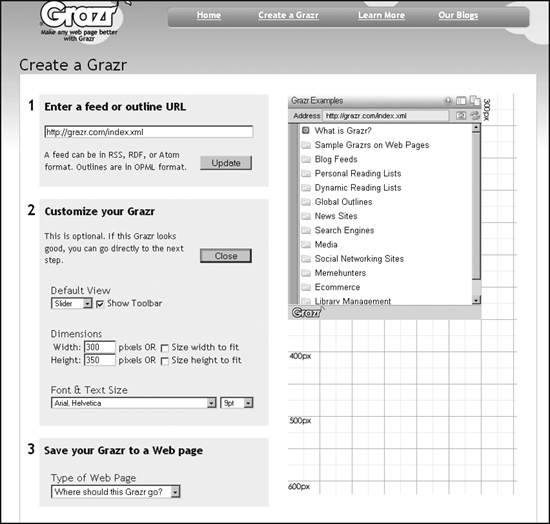
Ticker My Feed
Grazr is a good site, but not the only site that can help you create a box to put feed content on your site. The problem is that a lot of people don’t have the real estate on their page for a large RSS feed box. If you’re in that situation, try Ticker My Feed (tickermyfeed.com). You can use the free service to add either a traditional “box feed” or a small horizontal ticker through which an RSS feed will scroll. Ticker My Feed gives you a lot of control over the look and style of the feed (Figure 2).
Figure 2. Running low on screen real estate? Create a dynamic but small ticker for the RSS feed of your choice using Ticker My Feed.

RSS 2 GIF
Perhaps you don’t want to use a service like Grazr or Ticker My Feed because you don’t want to have any JavaScript on your site, or your visitors have browsers that can’t support JavaScript. If that’s the case, try RSS2GIF (rss2gif.com). This free service can turn an RSS feed into a GIF image file that you can put on your site. The GIF is clickable, and will take you to the RSS feed’s Web site. Best of all, the GIF image file automatically changes as the RSS feed updates (Figure 3).
Figure 3. From text to picture, RSS2GIF uses an RSS feed to create an image that changes as the feed is updated.
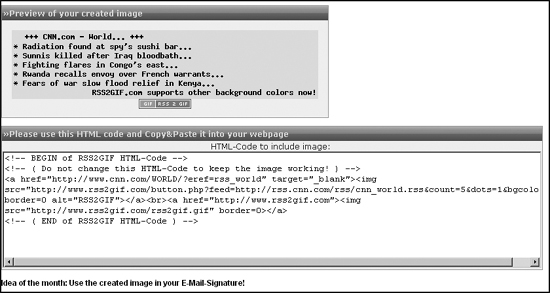
Creation Tools
If you use WordPress, Movable Type, or some other blog publishing system, there’s a good chance your site automatically generates RSS feeds. But if you’re not using software or a service that automatically creates RSS feeds for you, this section addresses some solutions that help you create your own.
FeedforAll
FeedforAll (feedforall.com) is an application you can download to your Windows-based or Mac-based computer and use it to create and update RSS feeds. You can also use the service to tweak plain feeds generated by content management systems. FeedforAll isn’t free—it’s $39.95 for a downloadable version. However, NotePage, Inc. (the company behind FeedforAll) also offers several PHP feeds that do various RSS tasks (Figure 4). One of them is free; the rest are free with the purchase of FeedforAll.
Figure 4. In addition to RSS software, Notepage offers several different RSS-related PHP scripts.
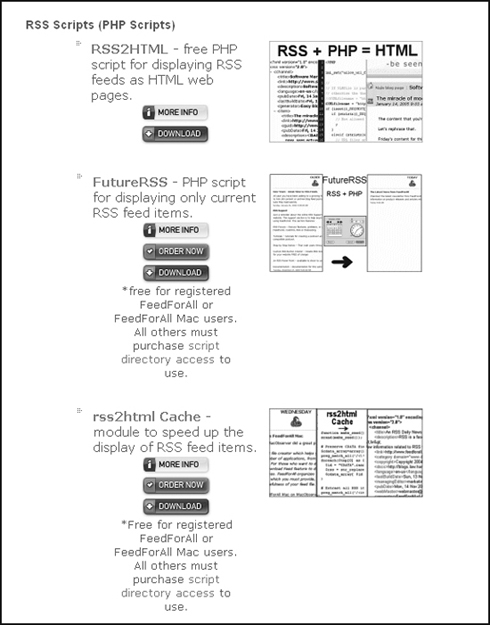
ListGarden
If you’re familiar with RSS and you want to try a free solution, check out ListGarden (softwaregarden.com/products/listgarden/index.html). The free service does not offer any support or a warranty, although it does have decent documentation and offers several tutorials. Like FeedforAll, it is a downloadable software application that lets you create and maintain RSS feeds. A version for Windows, a Perl version for Mac, and a generic Perl version are all available.
FeedPublish
If you want to maintain an RSS feed from several different computers, try FeedPublish (feedpublish.com), a Web-based way to create and maintain RSS feeds. This free service walks you through the process of creating and maintaining an RSS feed. It also tracks click-throughs on your feed and can send you reports via e-mail if you want them. The free feeds contain advertisements; Pro accounts, which cost $4.95 a month, omit the ads.
Filtering Tools
One complaint about RSS feeds is that sometimes they generate a lot of duplicates. This is especially true when you’re monitoring several different sites for similar keywords. One way to get rid of the duplicates is to put many RSS feeds into one large feed and filter out the duplicates. The services mentioned in this section help you do that.
FeedJumbler
If you want to put together a lot of different feeds quickly, you might like FeedJumbler (feedjumbler.com). This free service doesn’t even require registration—you simply enter what you want to call your feed and a list of feeds you want to include. FeedJumbler creates a feed for you in several different formats, and offers various options to change the look and contents of the feed.
FeedShake
FeedShake (feedshake.com) is a little more complicated than FeedJumbler and does require registration. You enter as many URLs as you want to include in a single feed and then log in. A feed page editor lets you specify a title for your feeds and use keyword filters to indicate what entries you want to add or remove from your RSS feed (Figure 5). The latter feature is useful when you want to monitor a site for keywords, but it doesn’t offer keyword-based RSS feeds. FeedShake is a free service.
Figure 5. FeedShake lets you combine feeds and filter them by keyword.

Miscellaneous Tools
You can do a lot of different things with RSS feeds. This section presents a few interesting, possibly useful, and definitely unclassifiable uses for RSS.
RSS2PDF
If you’re looking for a quick way to archive the content of RSS feeds on paper, RSS2PDF (rss2pdf.com) is a terrific solution (Figure 6). Simply enter the URL of the RSS feed in which you’re interested, and RSS2PDF produces a PDF file of that feed’s current content. This free service works best with full-content RSS feeds. The site also offers a desktop version of the service and RSS2PDF bookmarklets.
Figure 6. Want to save that feed for posterity? Turn it into a PDF!
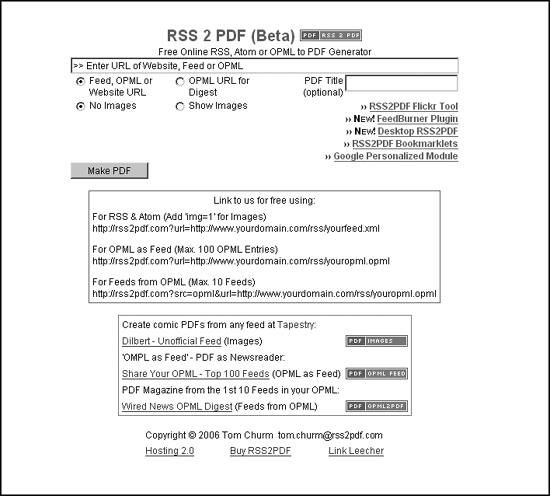
Feed 43
RSS feeds are terrific at tracking new content on Web sites or search results that match keywords. But what do you do when you just want to track a tiny bit of information on a Web site, such as a name or number? Feed43 (feed43.com) uses an easily configurable screen scraper to cull very small parts of information from a Web site and turn the information into an RSS feed (Figure 7). You can also use Feed43 to track Web sites that don’t have their own RSS feeds. Services start at $29 a year.
Figure 7. Feed43 uses patterned screen scraping to create RSS feeds focused on small bits of information.
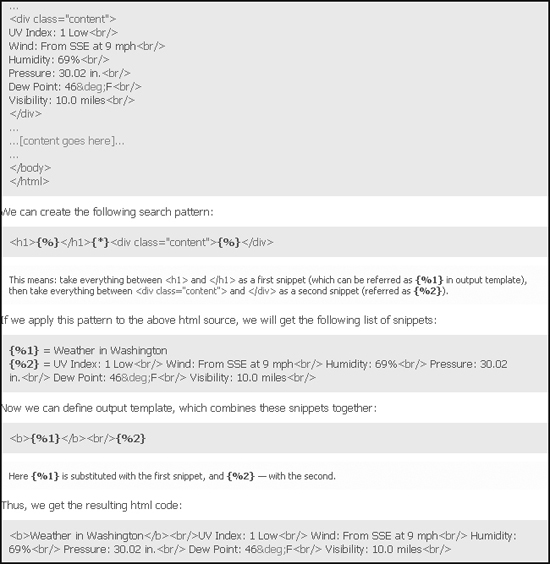
Feedcatch
RSS feeds aren’t designed to retain every update they publish. If they did, they’d be very, very long. Most RSS feeds contain information on only the last 10 to 20 items that have changed on a Web site. If you find yourself in a situation in which you know you will need the contents of an RSS feed for an upcoming project, but you don’t quite need it yet or don’t have the time to keep up with it, try Feedcatch (feedcatch.feedshake.com), a free service of Feedshake.
To use Feedshake, you enter the URL of the feed you want to archive, and then specify the maximum number of items you want to keep in the RSS feed and the number of hours old the contents of the feed can be. If you set both of those parameters to 0, Feedcatch will create a feed that stores its contents indefinitely.
Feed Validator
If you have to create and maintain your feed by hand, it will require a lot of time and effort—even if you use software to help you. So you want to make sure RSS readers can view the feed you’re putting so much effort into generating.
Feed Validator (feedvalidator.org) lets you know whether a URL you entered is a valid, working feed. The free service includes the text of your RSS feed, along with highlights of real and potential problems, with extensive documentation (Figure 8). Feed Validator can be nitpicky—sometimes it displays the message “This feed is valid, but may cause problems for some users.” But it provides a great way to learn about RSS feed syntax.
Figure 8. Feed Validator warns you not only about things that will break your feed, but also about things that could potentially cause trouble.
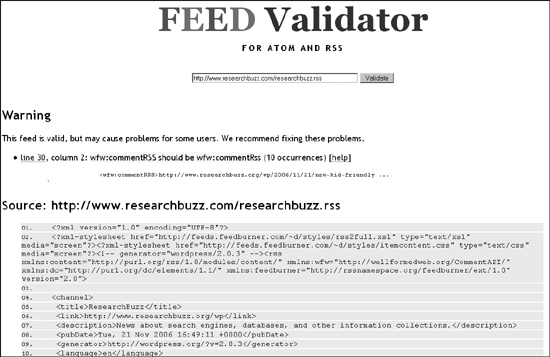
Pushing the Envelope
RSS feeds, along with e-mail alerts and Web page monitors, make it possible to capture meaningful information out of the enormous information flow that goes through the Internet every day—heck, every second. Using the tools in this bonus chapter, you can pursue the possibilities even further, from creating a way to funnel information back into the Internet, to making sure that the topic you want to monitor gets and stays captured.
Happy trapping!
